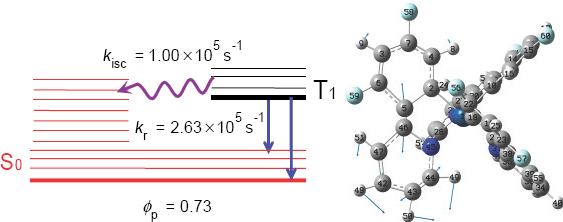

蓝光材料Ir(III)配合物的磷光效率与光谱的振动关联函数研究
收稿日期: 2013-01-22
网络出版日期: 2013-03-26
基金资助
项目受国家自然科学基金(Nos. 21290190, 91233105)和科技部973项目(Nos. 2009CB623600, 2013CB834703)资助.
Vibration Correlation Function Investigation on the Phosphorescence Quantum Efficiency and Spectrum for Blue Phosphorescent Ir(III) Complex
Received date: 2013-01-22
Online published: 2013-03-26
Supported by
Project supported by the National Natural Science Foundation of China (Nos. 21290190, 91233105) and the Ministry of Science and Technology of China through 973 Program (Nos. 2009CB623600, 2013CB834703).
由于发光效率低和稳定性差, 蓝色磷光材料一直是发光材料研究领域的瓶颈. 为了更深层次地理解蓝色磷光分子结构与发光效率之间的关系, 本工作结合密度泛函理论, 运用作者新近发展的系间窜越速率的振动关联函数计算方法, 定量研究了新型蓝光发射分子fac-tris(2-(4,6-difluorophenyl)pyridyl iridium (fac-Ir(F2ppy)3)的磷光光谱、辐射跃迁和无辐射跃迁速率及其与温度的依赖关系, 计算结果很好地解释了实验测量结果. 计算表明: (1)相较于未取代的绿光材料fac-Ir(ppy)3, 杂原子F的引入增加了T1与S0的能隙, 使得光谱蓝移, 但没有带来额外的分子结构弛豫的重整能, 从而使得该蓝色材料保持了高的发光效率; (2)无辐射跃迁过程所耗散的电子激发态能量主要是通过配体L1中的连接氟化苯环和吡啶环的C(5)—C(46)键、吡啶环内C(43)—C(44)键和C(42)—C(47)键及氟化苯环内的C(3)—C(6)键的伸缩振动, 因此, 理论研究表明可以通过分子设计来抑制这些振动来进一步提高这类材料的发光效率.

关键词: 系间窜越速率理论; 铱(III)配合物分子设计; 磷光光谱; 磷光量子效率
史清华 , 彭谦 , 孙少瑞 , 帅志刚 . 蓝光材料Ir(III)配合物的磷光效率与光谱的振动关联函数研究[J]. 化学学报, 2013 , 71(06) : 884 -891 . DOI: 10.6023/A13010113
A challenging issue for white organic light-emitting diodes is to improve the luminescence efficiency and stability for blue phosphorescence materials. In order to deeper understand the relationship between molecular structure and luminescence quantum efficiency, we apply our recently developed correlation function method coupled with density functional theory calculation to investigate the photophysical properties of fac-tris(2-(4,6-difluorophenyl)pyridyl iridium (fac-Ir(F2ppy)3), including phosphorescence emission spectra, radiative and nonradiative decay rates, and excited-state decay lifetime at different temperatures. All the calculated results can well reproduce the available experimental measurements. We further analyze the relevance of molecular parameters governing the photophysical processes. We found out that in fac-Ir(F2ppy)3: (1) when compared with the archetypal green fac-Ir(ppy)3, the introduction of F atoms can enlarge the energy gap between the excited triplet T1 and the ground state S0 resulting in blue-shift. This does not introduce extra reorganization energies in the excited-state relaxation process. So the blue phosphorescent fac-Ir(F2ppy)3 can exhibit high luminescence efficiency; (2) the main channels for nonradiatively dissipating the electronic excited-state energy are found to be the stretching vibrations of carbon and carbon bonds, such as C(5)—C(46) linking the fluorophenyl and pyridyl rings, C(43)—C(44) and C(42)—C(47) of pyridyl ring, and C(3)—C(6) of fluorophenyl ring in L1 ligand. This points out the direction for further increasing the light-emitting efficiency through suppressing these motions.

[1] Sun, Y.; Giebink, N. C.; Kanno, H.; Ma, B.; Thompson, M. E.; Forrest, S. R. Nature 2006, 440, 908.
[2] Lamansky, S.; Djurovich, P.; Murphy, D.; Abdel-Razzaq, F.; Lee, H.; Adachi, C.; Burrows, P. E.; Forrest, S. R.; Thompson, M. E. J. Am. Chem. Soc. 2001, 123(18), 4304.
[3] Kwong, R. C.; Nugent, M. R.; Michalski, L.; Ngo, T.; Rajan, K.; Tung, Y.; Weaver, M. S.; Zhou, T. X.; Hack, M.; Thompson, M. E.; Forrest, S. R.; Brown, J. J. Appl. Phys. Lett. 2002, 81(1), 162.
[4] Tokito, S.; Iijima, T.; Tsuzuki, T.; Sato, F. Appl. Phys. Lett. 2003, 83(12), 2459.
[5] Tsuboyama, A.; Iwawaki, H.; Furugori, M.; Mukaide, T.; Kamatani, J.; Igawa, S.; Moriyama, T.; Miura, S.; Takiguchi, T.; Okada, S.; Hoshino, M.; Ueno, K. J. Am. Chem. Soc. 2003, 125(42), 12971.
[6] Baldo, M. A.; O'Brien, D. F.; You, Y.; Shoustikov, A.; Sibley, S.; Thompson, M. E.; Forrest, S. R. Nature 1998, 395(6698), 151.
[7] Sajoto, T.; Djurovich, P. I.; Tamayo, A. B.; Oxgaard, J.; Goddard, W. A.; Thompson, M. E. J. Am. Chem. Soc. 2009, 131(28), 9813.
[8] Endo, A.; Suzuki, K.; Yoshihara, T.; Tobita, S.; Yahiro, M.; Adachi, C. Chem. Phys. Lett. 2008, 460(1~3), 155.
[9] Wang, L. X.; Mei, Q. B.; Yan, F.; Tian, B.; Weng, J. N.; Zhang, B.; Huang, W. Acta Phys.-Chim. Sin. 2012, 28(7), 1556. (王玲霞, 梅群波, 颜芳, 田波, 翁洁娜, 张彬, 黄维, 物理化学学报, 2012, 28(7), 1556.)
[10] Tao, R.; Qiao, J.; Duan, L.; Qiu, Y. Prog. Chem. 2010, 22(12), 2255. (陶然, 乔娟, 段炼, 邱勇, 化学进展, 2010, 22(12), 2255.)
[11] Jansson, E.; Minaev, B.; Schrader, S.; Ågren, H. Chem. Phys. 2007, 333(2~3), 157.
[12] Peng, Q.; Niu, Y.; Shi, Q.; Gao, X.; Shuai, Z. J. Chem. Theory Comput. 2013, 9(2), 1132.
[13] Jiang, Y. Q.; Peng, Q.; Gao, X.; Shuai, Z. G.; Niu, Y. L.; Lin, S. H. J. Mater. Chem. 2012, 22, 4491.
[14] Tamayo, A. B.; Alleyne, B. D.; Djurovich, P. I.; Lamansky, S.; Tsyba, I.; Ho, N. N.; Bau, R.; Thompson, M. E. J. Am. Chem. Soc. 2003, 125(24), 7377.
[15] Dedeian, K.; Shi, J.; Shepherd, N.; Forsythe, E.; Morton, D. C. Inorg. Chem. 2005, 44(13), 4445.
[16] Park, N. G.; Choi, G. C.; Lee, Y. H.; Kim, Y. S. Curr. Appl. Phys. 2006, 6(4), 620.
[17] Lin, S. H.; Chang, C. H.; Liang, K. K.; Chang, R.; Shiu, Y. J.; Zhang, J. M.; Yang, T. S.; Hayashi, M.; Hsu, F. C. Adv. Chem. Phys. 2002, 1.
[18] Niu, Y.; Peng, Q.; Deng, C.; Gao, X.; Shuai, Z. J. Phys. Chem. A 2010, 114(30), 7817.
[19] Ianconescu, R.; Pollak, E. J. Phys. Chem. A 2004, 108(39), 7778.
[21] Dalton, a molecular electronic structure program, Release Dalton2011 (2011), see http://daltonprogram.org.
[22] Minaev, B.; Ågren, H. Chem. Phys. 2005, 315(3), 215.
[23] Vahtras, O.; Ågren, H.; Jorgensen, P.; Jensen, H. J. A.; Helgaker, T.; Olsen, J. J. Chem. Phys. 1992, 97(12), 9178.
[24] Koseki, S.; Fedorov, D. G.; Schmidt, M. W.; Gordon, M. S. J. Phys. Chem. A 2001, 105(35), 8262.
[25] Koseki, S.; Schmidt, M. W.; Gordon, M. S. J. Phys. Chem. A 1998, 102(50), 10430.
[26] Li, X.; Minaev, B.; Ågren, H.; Tian, H. J. Phys. Chem. C 2011, 115(42), 20724.
[27] Minaev, B.; Ågren, H.; Angelis, F. D. Chem. Phys. 2009, 358(3), 245.
[28] Minaev, B.; Minaeva, V.; Ågren, H. J. Phys. Chem. A 2009, 113(4), 726.
[29] Li, X.; Minaev, B.; Ågren, H.; Tian, H. Eur. J. Inorg. Chem. 2011, 2011(16), 2517.
[30] Yersin, H.; Finkenzeller, W. J. In Highly Efficient OLEDs with Phosphorescent Materials, Ed.: Yersin, H., Wiley-VCH Verlag GmbH & Co. KgaA, Weiheim, Germany, 2008, pp. 1~98.
/
| 〈 |
|
〉 |